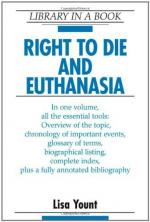|
This section contains 1,785 words (approx. 6 pages at 300 words per page) |

|
Leslie Burkholder
About the author: Leslie Burkholder is an instructor in the department of philosophy at the University of British Columbia in Vancouver, Canada.
There is no ethical distinction between passive euthanasia, where treatment is withheld or withdrawn from a patient who then dies, or active euthanasia, where a physician gives a lethal dose of medication to end a patient's life. A slippery slope argument can be used to support this perspective. If, for example, it is ethical to turn off a ventilator keeping alive a terminally ill patient, then it would be moral to turn off a similar patient's artificial lungs, even though they were located within her body while the first patient's ventilator was outside her body. There is no moral distinction between these cases. By the same...
|
This section contains 1,785 words (approx. 6 pages at 300 words per page) |

|




